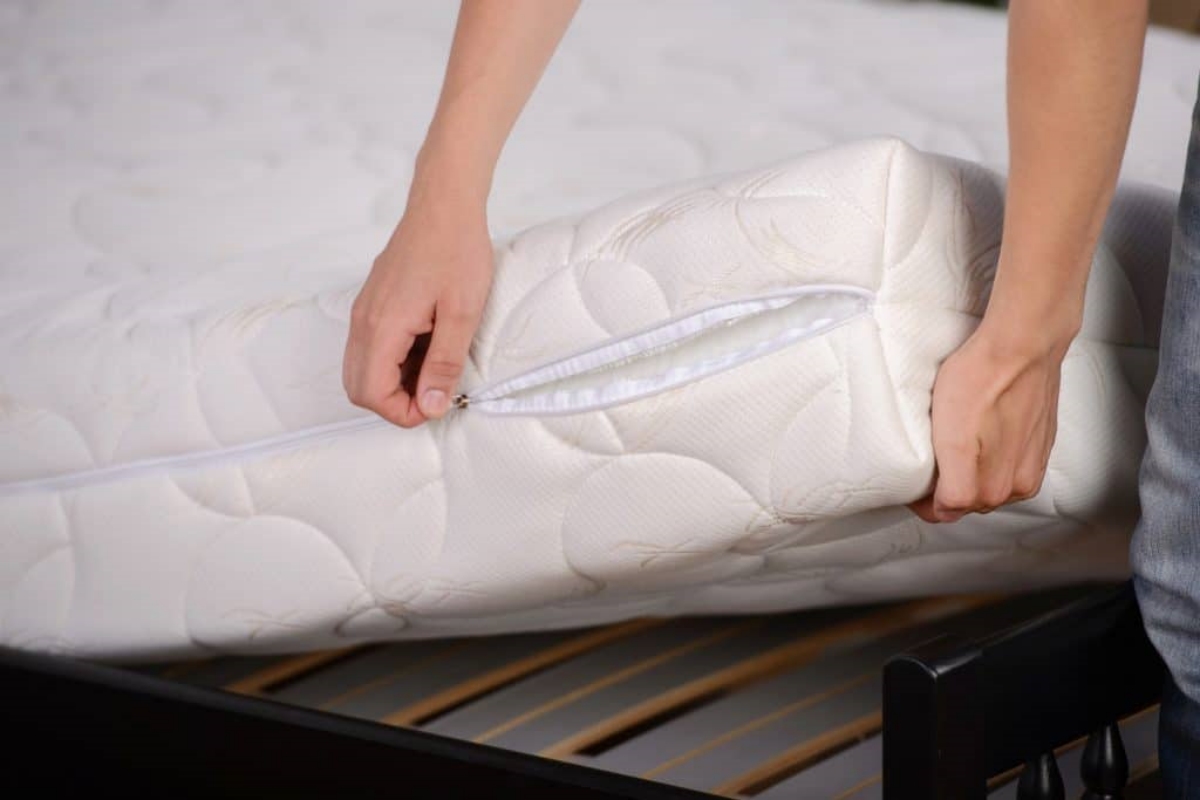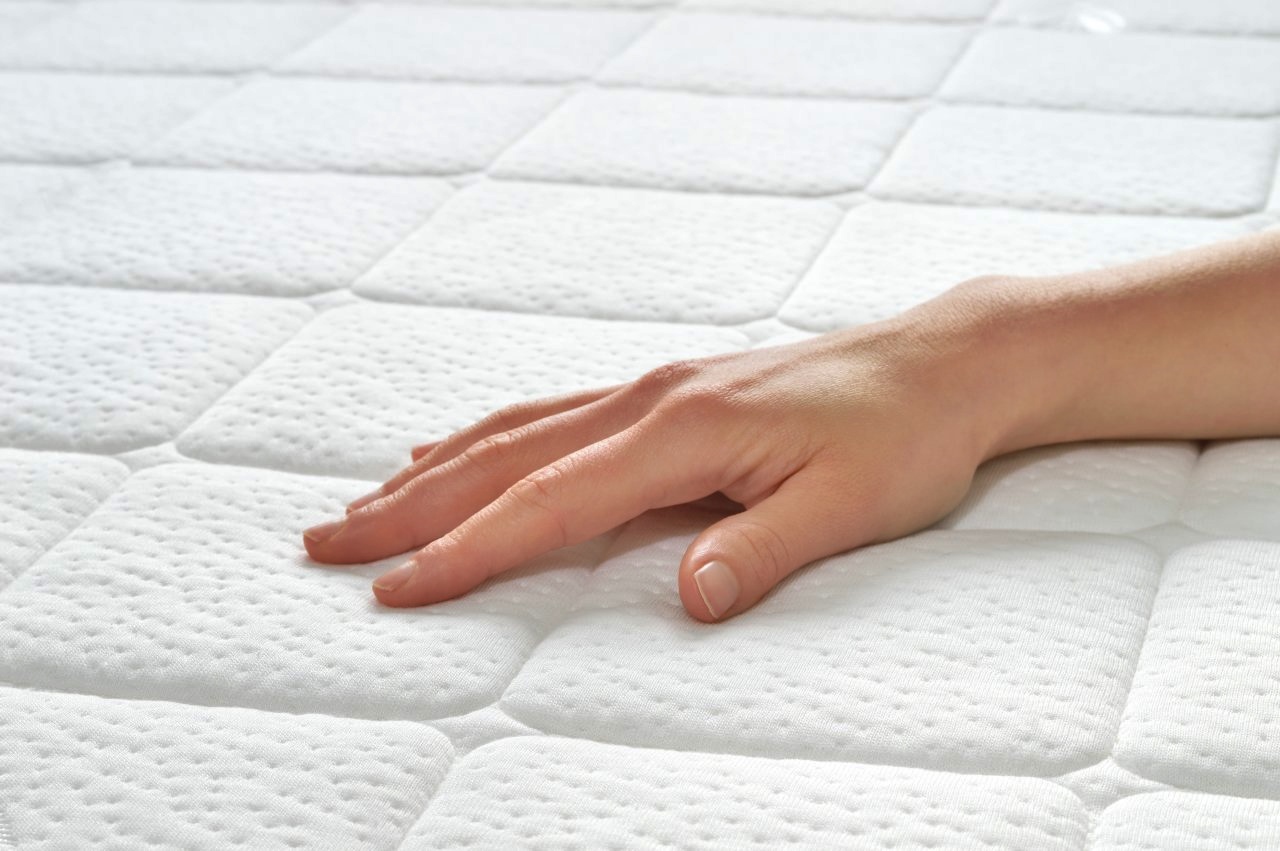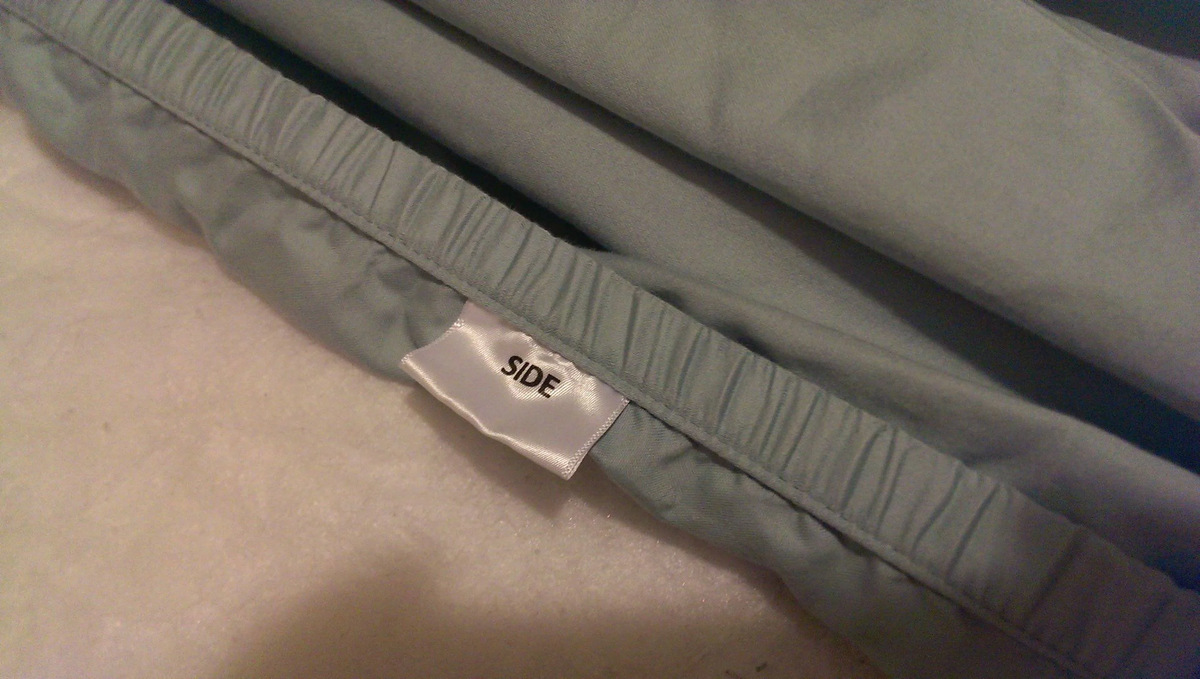Home>Furniture>Bedroom Furniture>Why Is It Illegal To Remove A Mattress Tag


Bedroom Furniture
Why Is It Illegal To Remove A Mattress Tag
Modified: March 2, 2024
Discover why removing a mattress tag is illegal and learn about the importance of tags in bedroom furniture.
(Many of the links in this article redirect to a specific reviewed product. Your purchase of these products through affiliate links helps to generate commission for Storables.com, at no extra cost. Learn more)
Introduction
When you purchase a new mattress, you may have noticed a tag attached to it with a stern warning that states: “Do not remove under penalty of law.” This simple tag has sparked curiosity and intrigue among many consumers. Why is it illegal to remove a mattress tag? What purpose does it serve? In this article, we will delve into the world of mattress tags, exploring their purpose, the importance of consumer information, relevant consumer protection laws, and the consequences of removing mattress tags.
While it may seem perplexing that removing a small tag could be against the law, the reasoning behind this restriction becomes clearer once we understand the role of mattress tags in protecting consumer rights and ensuring product safety. Let’s dive in and uncover the mysteries behind mattress tags.
Key Takeaways:
- Mattress tags are not just a legal requirement; they provide crucial information about materials, safety certifications, and origin, empowering consumers to make informed decisions and promoting transparency in the marketplace.
- Removing mattress tags can lead to legal, warranty, and return difficulties. Manufacturers and retailers play a vital role in upholding labeling requirements and ensuring consumer protection.
Read more: Why Is It Illegal To Cut Off Mattress Tags
The Purpose of Mattress Tags
Mattress tags serve a crucial purpose in the realm of consumer protection. They provide valuable information about the mattress, including its composition, origin, and safety certifications. These tags serve as a form of transparency, allowing consumers to make well-informed decisions before purchasing a mattress.
One of the primary functions of mattress tags is to disclose the materials used in the construction of the mattress. This information is essential for individuals with allergies or sensitivities to certain materials. By reading the tag, consumers can easily determine if the mattress contains any potential allergens, such as latex or certain synthetic materials.
In addition to disclosing materials, mattress tags often include details about the manufacturing process and country of origin. This information ensures that consumers can make informed decisions about the quality and safety standards associated with the mattress. For example, it may be important to some consumers to know if their mattress is made locally or if it has undergone rigorous testing to comply with safety regulations.
Moreover, mattress tags often feature safety certifications that verify compliance with industry standards and regulations. These certifications provide consumers with assurance that the mattress has been subjected to rigorous testing to meet safety and performance requirements. Examples of such certifications include CertiPUR-US, which confirms that the foam in the mattress is free from harmful chemicals, and the Oeko-Tex Standard 100, which ensures that textiles used in the mattress are free from harmful substances.
By having this information readily available on mattress tags, consumers have the ability to make informed decisions based on their personal needs and preferences. Mattress tags play a crucial role in allowing consumers to have transparency in the mattress buying process, enabling them to select a product that aligns with their values and promotes their well-being.
The Importance of Consumer Information
Consumer information plays a pivotal role in empowering individuals to make informed decisions about the products they purchase, including mattresses. Transparent and complete information allows consumers to assess the quality, safety, and suitability of a mattress before making a purchase.
When it comes to mattresses, consumers spend a significant amount of time, often several hours a night, sleeping on them. As such, it is crucial for consumers to be aware of the materials used in the mattress, potential allergens, and any safety certifications. This knowledge allows consumers to choose a mattress that aligns with their specific needs, preferences, and health concerns.
Providing accurate and comprehensive information through mattress tags gives consumers peace of mind. It allows them to trust that they are making an informed decision and investing in a mattress that will promote their comfort, safety, and overall well-being. Consumer information also helps individuals avoid potential hazards or risks associated with certain materials or manufacturing processes.
Beyond individual consumers, the availability of clear and accurate information on mattress tags also benefits the broader community. Transparent product labeling fosters a culture of accountability and encourages manufacturers to adhere to safety standards, quality control measures, and ethical manufacturing practices. It promotes fair competition among mattress manufacturers and holds them accountable for the claims they make about their products.
Furthermore, consumer information enables individuals to exercise their rights and seek redress in case of product defects or misrepresentations. If a consumer experiences issues with a mattress, having access to detailed information on the mattress tag allows them to determine if the issue is covered by warranty or if there are specific steps they need to follow to resolve the problem.
In summary, the importance of consumer information cannot be overstated. By providing detailed and accurate information on mattress tags, manufacturers empower consumers to make informed decisions, promote their own well-being, and contribute to a marketplace that values transparency and consumer rights.
Consumer Protection Laws
Consumer protection laws are in place to safeguard the rights and interests of consumers in their interactions with businesses and to ensure fair and ethical practices in the marketplace. These laws play a significant role in protecting consumers from deceptive practices, misleading information, and unsafe products.
When it comes to mattresses, there are specific consumer protection laws that regulate the information provided to consumers and govern the manufacturing and sale of mattresses. These laws aim to ensure that consumers have access to accurate and meaningful information about the products they purchase and that the mattresses meet certain safety standards.
One of the principal laws pertaining to mattresses is the Textile Fiber Products Identification Act (TFPIA). This law mandates that each mattress must have a label that discloses the fiber content, allowing consumers to understand the materials used in its construction. The Federal Trade Commission (FTC) enforces this law and monitors compliance to protect consumers from false or misleading claims about the materials used.
Another important consumer protection law is the Consumer Product Safety Act (CPSA). This law establishes safety standards for various consumer products, including mattresses. The CPSA enables the Consumer Product Safety Commission (CPSC) to regulate and enforce safety requirements for mattresses, ensuring that they meet specific flammability standards and do not pose undue risks to consumers.
Additionally, consumer protection laws require manufacturers and retailers to provide warranties for mattresses. These warranties outline the terms and conditions under which the mattress will be repaired, replaced, or refunded if defects or issues arise. The Magnuson-Moss Warranty Act governs these warranties, ensuring that consumers have clear and fair terms for product support and protection against defective mattresses.
By enforcing these consumer protection laws, governments strive to create a marketplace that prioritizes consumer safety, transparency, and fair business practices. Regulatory agencies actively monitor compliance with these laws, and violations can result in penalties, fines, or legal action against non-compliant manufacturers or retailers.
Consumers are encouraged to familiarize themselves with their rights and the specific laws in their jurisdiction to protect themselves from unscrupulous practices and to make informed decisions when purchasing a mattress or any other consumer product.
Labeling Requirements for Mattresses
Labeling requirements for mattresses are established to ensure that consumers have access to vital information about the product they are purchasing. These requirements vary from country to country but generally involve specific details that must be disclosed on the mattress label or tag.
One of the primary labeling requirements for mattresses is the disclosure of the mattress’s contents. This includes information about the materials used in the mattress’s construction, such as foam, innersprings, or natural fibers. By providing this information, consumers can make informed choices based on their preferences, needs, and any specific requirements, such as allergies or sustainability concerns.
In many jurisdictions, mattresses are also required to disclose the country of origin. This information informs consumers about where the mattress was manufactured, which can be an important factor for those who prioritize supporting local industries or have concerns about certain manufacturing practices in specific regions.
Furthermore, labeling requirements often mandate that safety certifications and compliance with specific standards are indicated on the mattress tag. These certifications ensure that the mattress has undergone testing to meet safety regulations. Examples of such certifications include CertiPUR-US and Oeko-Tex Standard 100, which certify the use of safe materials and absence of harmful substances.
In addition to material content and safety certifications, mattress labels may include other relevant information, such as the mattress’s dimensions, weight, or care instructions. These details support consumers in making an informed decision and maintaining the mattress properly to ensure its longevity and performance.
It is important to note that non-compliance with labeling requirements can have serious consequences for manufacturers and retailers. Penalties may range from fines to legal action, as regulatory bodies prioritize consumer protection and transparency in the marketplace.
By adhering to labeling requirements, manufacturers and retailers demonstrate their commitment to providing accurate information and ensuring consumer satisfaction. This compliance fosters trust and confidence in the industry and allows consumers to make informed choices when selecting a mattress that meets their specific needs and aligns with their values.
The Consequences of Removing Mattress Tags
Removing mattress tags may seem like a minor act, but it can lead to significant consequences for both consumers and manufacturers. The consequences of removing mattress tags range from legal ramifications to potential difficulties in warranty claims and product returns.
One of the primary reasons why removing mattress tags is against the law is to prevent fraud and misrepresentation. The information on the tags, such as material composition and safety certifications, is crucial for consumers to make informed decisions about their purchase. By removing the tag, consumers may unknowingly buy a product that does not meet their specific requirements or may not have gone through the necessary testing and safety checks.
Moreover, removing mattress tags can potentially void the manufacturer’s warranty. Most warranties require the mattress to be in its original condition, including the intact tag, for claims to be eligible. If a consumer removes the tag, they may find themselves ineligible for warranty coverage if any issues arise with the mattress in the future.
In some cases, removing mattress tags can make it difficult for consumers to return or exchange the product. Many retailers have policies that require the product to be in its original condition, including the tag, to be eligible for returns or exchanges. By removing the tag, consumers may encounter challenges in seeking recourse if they are dissatisfied with the mattress.
Additionally, it’s worth noting that removing mattress tags can have legal implications. While the penalties for removing the tag are rarely enforced against consumers, they serve as a deterrent to prevent unauthorized removal. However, manufacturers and retailers can face more severe consequences if they sell mattresses with removed tags, including fines and legal action for non-compliance with labeling regulations.
In summary, the consequences of removing mattress tags extend beyond the act itself. It can potentially lead to legal, warranty, and return difficulties for consumers. As such, it is essential for consumers to leave the tag intact, ensuring they have access to accurate information, warranty coverage, and the ability to seek recourse if needed. Adhering to the tag removal laws not only protects consumers but also contributes to maintaining trust and transparency in the mattress industry.
Tip: It is illegal to remove a mattress tag because it contains important information about the materials used in the mattress and serves as a consumer protection measure. Always check the tag before purchasing a mattress.
Exceptions and Exemptions to Tag Removal
While it is generally illegal to remove mattress tags, there are certain exceptions and exemptions to this rule. Understanding these exceptions can help clarify the circumstances in which removal is permissible.
One significant exception is for the manufacturer or retailer. During the manufacturing and shipping process, it is common for the mattress to be handled and moved multiple times. In some cases, the tag may become detached or damaged. In these instances, the manufacturer or retailer may remove the tag before the mattress reaches the consumer. However, it is important to note that once the mattress is in the possession of the consumer, the tag should remain intact.
Another exception is for the purposes of maintenance and cleaning. If the tag becomes soiled and interferes with the ability to clean the mattress effectively, removing it solely for cleaning purposes may be permissible. However, it is important to exercise caution and ensure that the tag is reattached properly after cleaning.
There are also exemptions for antique mattresses and mattresses that are resold. Antique mattresses, defined as those over a certain age specified by local regulations, are often exempt from tag removal laws. This exemption recognizes that antique mattresses may not have tags that meet current labeling requirements but still allows for their sale and purchase as historical or collectible items.
Similarly, mattresses that are resold by individuals (such as through classifieds or garage sales) may not be required to bear the original tag. However, it is important for sellers to disclose relevant information about the mattress, including its age, condition, and any known issues or allergens, to ensure transparency and consumer awareness.
It is crucial to note that these exceptions and exemptions may vary between jurisdictions and be subject to local regulations. It is advisable for consumers to familiarize themselves with the specific laws in their region to understand any additional allowances or restrictions regarding mattress tag removal.
While exceptions and exemptions exist, it is generally recommended to leave the mattress tag intact whenever possible. This ensures that consumers have access to important information about the mattress and maintain eligibility for warranties, returns, and potential legal protections.
The Role of Retailers and Manufacturers
Both retailers and manufacturers play critical roles in ensuring the integrity of mattress tags and complying with consumer protection laws. Their responsibilities extend beyond simply attaching tags to mattresses; they must also prioritize transparency, quality assurance, and adherence to labeling regulations.
Manufacturers are responsible for ensuring that the information on mattress tags is accurate and up to date. This includes providing clear details about the materials used in the mattress’s construction, safety certifications obtained, and compliance with relevant industry standards. Manufacturers must also ensure that the tags are securely attached to the mattress so that consumers can access the information easily.
In addition to complying with labeling requirements, manufacturers have the responsibility of conducting quality control checks throughout the manufacturing process. This helps to ensure that the finished mattress meets safety standards, performs as expected, and is free from defects. By prioritizing quality control, manufacturers can reduce the likelihood of issues or complaints from consumers and maintain a positive reputation in the market.
Retailers also play a crucial role in promoting and upholding consumer protection laws. It is the retailer’s responsibility to ensure that the mattresses they sell comply with labeling requirements and safety standards. This includes sourcing products from reputable manufacturers and suppliers who demonstrate a commitment to quality and compliance. Retailers should actively verify that the mattresses they stock have intact and accurate tags before offering them for sale.
Moreover, retailers serve as a bridge between manufacturers and consumers, providing vital information about the mattresses they carry, including material composition, safety certifications, and warranty details. They should be knowledgeable about the products they sell and be able to address any questions or concerns raised by consumers regarding the mattress tags.
Both manufacturers and retailers should prioritize consumer education and ensure that customers are aware of the importance of mattress tags. Through clear communication and transparency, they can help consumers understand the significance of the tags, the information they provide, and the implications of removing them.
By fulfilling their roles diligently, manufacturers and retailers contribute to a marketplace that values consumer rights, promotes transparency, and protects individuals from deceptive or unsafe practices. Collaboration between manufacturers and retailers is key in ensuring that mattresses meet regulatory requirements and that consumers have access to accurate information, enabling them to make informed decisions and purchase products that align with their needs and preferences.
Enforcement of Mattress Tag Regulations
The enforcement of mattress tag regulations ensures that manufacturers, retailers, and consumers comply with the laws governing the proper use and preservation of mattress tags. Regulatory authorities and organizations play a crucial role in monitoring and enforcing these regulations to maintain consumer protection and promote transparency in the market.
One of the main enforcement agencies in the United States is the Federal Trade Commission (FTC). The FTC oversees the compliance of mattress manufacturers, ensuring that they adhere to labeling requirements and provide accurate information on mattress tags. They may conduct inspections, carry out investigations, and take enforcement action against non-compliant manufacturers or retailers.
Additionally, the Consumer Product Safety Commission (CPSC) has authority over safety standards and regulations related to mattresses. This includes the enforcement of flammability standards and the prevention of hazardous materials in the construction of mattresses. The CPSC monitors compliance with these regulations and may take enforcement measures against those who fail to meet the necessary safety requirements.
Enforcement actions may involve penalties, fines, or legal action against manufacturers or retailers found to be non-compliant with mattress tag regulations. These penalties serve as deterrents and consequences for individuals or companies who attempt to deceive consumers or compromise their safety.
Consumer watchdog organizations and industry associations also play a significant role in enforcing mattress tag regulations. These organizations often advocate for consumer rights, promote awareness of the importance of mattress tags, and may conduct their own investigations or campaigns to ensure compliance with labeling requirements. They can play a vital educational role in educating consumers about their rights and helping them understand the significance of mattress tags.
It is important for consumers to be aware of their rights and report any instances of non-compliance or deceptive practices related to mattress tags. By providing valuable information and evidence, consumers can contribute to the enforcement efforts and help protect themselves and other consumers from unscrupulous businesses.
In summary, the enforcement of mattress tag regulations is carried out by government agencies, regulatory bodies, consumer watchdog organizations, and industry associations. Through inspections, investigations, and penalties, these entities work together to uphold consumer protection laws, promote transparency, and ensure the proper use and preservation of mattress tags.
Read more: Where Is The Tag On A Tempur-Pedic Mattress
Proposed Changes to Tag Removal Laws
In recent years, there have been discussions and proposals to modify or amend the laws surrounding the removal of mattress tags. These proposed changes aim to address certain challenges and concerns while balancing consumer rights and industry regulations.
One aspect of the proposed changes involves providing clearer guidelines and exceptions for tag removal. Advocates argue that more specific instructions would help consumers understand when and how it is acceptable to remove mattress tags without violating the law. This could include providing guidelines for situations such as cleaning, repair, or when the tag becomes illegible or damaged.
Another proposed change centers around modernizing labeling requirements to meet evolving consumer demands and technological advancements. This could involve incorporating digital or electronic tags that contain all the necessary information but can be easily accessed and updated by consumers through their devices. This type of technology would provide convenience for consumers while still ensuring compliance with labeling regulations.
Additionally, some proposals seek to streamline and harmonize mattress tag regulations across different jurisdictions. This would create consistency and clarity for both consumers and manufacturers, reducing confusion and facilitating compliance. By aligning labeling requirements and enforcement practices, this change would make it easier for all parties to navigate the rules associated with mattress tags.
Furthermore, there are discussions about exploring alternative methods of providing relevant information to consumers. This could involve using QR codes, scannable labels, or augmented reality (AR) technology to deliver accurate and detailed information about the mattress. These interactive solutions would enhance consumer experience and engagement while ensuring compliance with information disclosure regulations.
It is essential to note that proposed changes to tag removal laws may vary across different jurisdictions and may take time to be implemented. Government agencies, regulatory bodies, and industry stakeholders are carefully evaluating these proposals to strike a balance between consumer protection, technological advancements, and practical considerations.
Ultimately, the goal of these proposed changes is to adapt mattress tag regulations to the evolving needs and expectations of consumers and manufacturers. By embracing innovation and enhancing clarity, these changes aim to improve the consumer experience, promote industry accountability, and ensure transparency in the mattress marketplace.
Conclusion
Mattress tags may seem like a small detail, but they serve a crucial purpose in providing consumers with valuable information and protecting their rights. These tags disclose important details about the materials, origin, and safety certifications of mattresses, allowing consumers to make informed decisions based on their preferences and needs.
Throughout this article, we explored the purpose of mattress tags and their role in promoting consumer information and safety. We discussed the importance of transparency in the marketplace and how mattress tags contribute to creating a culture of accountability and fair business practices.
We also delved into the consequences of removing mattress tags, highlighting the potential legal ramifications, warranty voidance, and difficulties in returns or exchanges that consumers may face when tags are removed. Compliance with mattress tag regulations should be upheld by both manufacturers and retailers to ensure consumer protection and maintain trust in the market.
While there are exceptions and exemptions to tag removal, such as for antique mattresses or cleaning purposes, it is generally advised to leave the tags intact whenever possible to maintain consumer rights and access to important information.
We also discussed the enforcement of mattress tag regulations, with regulatory bodies, consumer watchdog organizations, and industry associations playing a vital role in upholding compliance, promoting transparency, and protecting consumer interests.
Furthermore, we touched on proposed changes to tag removal laws, emphasizing the need for clearer guidelines, modernizing labeling requirements, harmonizing regulations, and exploring alternative methods of delivering information to consumers.
In conclusion, mattress tags are not just simple tags attached to mattresses; they are symbols of consumer education, transparency, and accountability. By understanding the purpose and importance of these tags, consumers can make informed decisions and advocate for their rights. Manufacturers and retailers have a responsibility to uphold labeling requirements and provide accurate information, safeguarding consumer trust and satisfaction.
As consumers, it is crucial to recognize the significance of mattress tags and the role they play in protecting our interests. By valuing transparency and being informed about our rights, we can make well-informed choices and contribute to a marketplace that prioritizes consumer well-being and product safety.
Frequently Asked Questions about Why Is It Illegal To Remove A Mattress Tag
Was this page helpful?
At Storables.com, we guarantee accurate and reliable information. Our content, validated by Expert Board Contributors, is crafted following stringent Editorial Policies. We're committed to providing you with well-researched, expert-backed insights for all your informational needs.













